Turns on a wood lathe. How to choose a desktop wood lathe for home
The main requirements for a lathe for the home are to maintain functionality while reducing size and noise. The power of amateur woodworking devices is much lower than professional ones, but the skillful hands of craftsmen create original, useful things even on small desktop machines.
Properties and characteristics
Using amateur equipment, you can make souvenirs, dishes, small things for the interior, furniture parts from wood, sharpen tools and drills, choose grooves, and carve with your own hands. Details are being processed complex shapes, conical and cylindrical.
With the right equipment, you can sharpen not only wood, but also some types of plastics and soft metals.
Features of compact models for the home:
- low power - 350 - 500 W;
- small weight - from 17 to 40 kg;
- workpiece rotation speed within 400 - 3400 rpm.
On the most productive lathes in this class, you can make small batches of parts for sale with your own hands.
Design and principle of operation
All components and parts of the lathe are located on the frame or bed. Main structural elements: front support with drive and transmission shaft, rear support for fixing the workpiece and mobile stand under the cutter In there is a driving chuck, which transmits the rotational movement to the workpiece. The tailstock holds the free end of the workpiece, it is especially necessary when working with long parts. A cutter stand or thrust pad keeps the cutter in the right place.
The workpiece is fixed in the lathe between the centers of the supports or on the faceplate. When working with wood blanks, the first method is more often used, which does not allow to process the ends. Fastening on the faceplate is used in the processing of end surfaces, it is more reliable. The part is fixed with bolts, not chuck teeth.
When fastening, it is important to center the part so that it does not “beat” during movement. For this, an angular type center finder is provided.
The cutter feed is carried out manually, it is fixed only when working with a copier. In other cases, the master holds the cutter with his own hands with an emphasis on the thrust bearing.
The workpiece is machined in two passes:
- draft: at an angle of up to 30 degrees;
- final: at an angle up to 45 degrees.
For each entry, material is removed with a thickness of not more than 1 millimeter.
Choosing lathe for home use, you should pay attention to the amount of spindle runout. A very good result is 0.02 mm, because working on do-it-yourself woodworking equipment does not imply perfect accuracy.
Overview of the most popular models
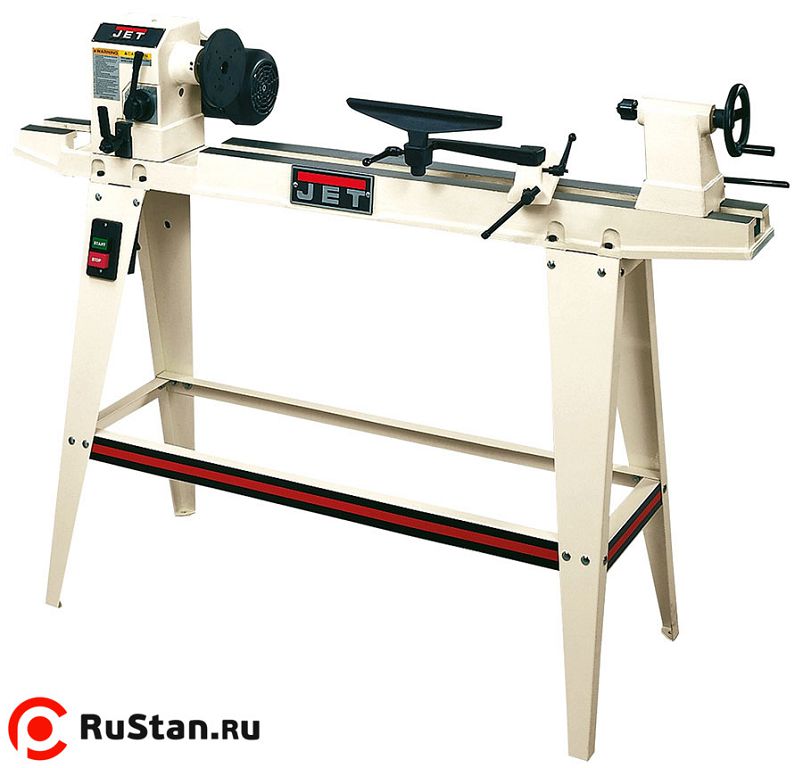
Consider the characteristics of several models of lathes for amateur use.
| Kinzo 48P5600 | Proxxon DB250 | Jet JML-1014i | Caliber STD-350 | Corvette 71 | |
| Type | desktop | desktop | desktop | desktop | desktop |
| Power, W | 350 | 100 | 370 | 350 | 370 |
| Electric motor type | asynchronous | collector | collector | collector | asynchronous |
| Rotation speed, rpm | 850 — 2150 | 1000-5000 | 500 — 3900 | 500 — 3400 | 760 — 3200 |
| Maximum workpiece dimensions | 1000 x 350 | 250 x 80 | 350 x 250 | 330 x 250 | 420 x 250 |
| Spindle size | 1 x 8″ | M16x1 | 1 x 8″ | 1 x 8″ | 1 x 8″ |
| Weight, kg | 38 | 2 | 30 | 17,5 | 38 |
Table 1. Technical characteristics of lathes for the home
Kinzo 48P5600: tube bed rectangular section, the use of an extension cord for processing workpieces longer than 40 cm is provided. You can change the speed of rotation of the workpiece by rearranging the belt on the pulleys (4 pairs). When buying such a machine, you should pay attention to the alignment of the front and rear axles. When pressed by the rear pillar, the base may be deformed. fragile plastic handles on clamp bolts.
Jet JML-1014i: solid cast iron bed. The rotation speed changes smoothly in several ranges. To change the range, you need to rearrange the belt on the pulley. It works very quietly, it is convenient to set the speed on the electronic unit. To lock the spindle, a push handle is provided, which is located on the left.
Proxxon DB250: aluminum bed, very small dimensions, allows you to turn only the smallest parts for aeromodelling. During operation, it is desirable to attach the device to the workbench, otherwise the light alloy structure will hang out. It works very quietly, there is no beating, but the power of the machine is small, so you need to work carefully and slowly.
Corvette 71: cast iron frame, rotation speed is changed by shifting on the belt pulleys. In spite of small size, the design does not differ from the professional turning equipment. The engine maintains stable turns, practically does not vibrate and does not make noise. The handpiece is short, it is clearly not enough for internal turning of parts longer than 110 mm. Equipped with a convenient eccentric mechanism for rearranging the armrest.
Caliber STD-350: neat cast iron frame. The center of the rear and front axles may not coincide, which is very difficult when working with short parts made of dense wood. The spindle does not beat, it is easy to adjust, a solid bed, it works quietly. Weak frequency regulator - torque at the minimum position is almost impossible to use.
Homemade lathe
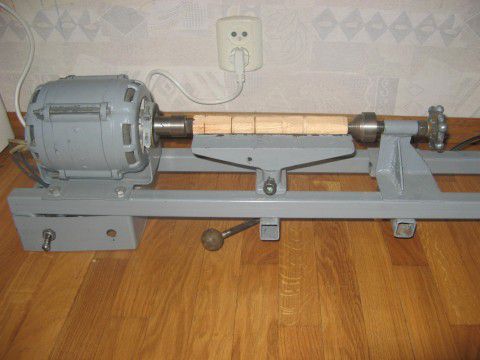
With your own hands at home you can collect turning device, in no way inferior to the factory.
Materials for the frame: wood, ferrous metal (for welding), light alloys (bolted), textolite. The main thing is that the structure is stable and strong, and the centers of the attendants coincide.
Drive: the easiest way is to take the finished part from an old drill, but it will do asynchronous electric motor from any equipment with a power of at least 150 watts.
Guides: depending on the material of the case, this can be a slot in the base, wooden slats or a self-mounted aluminum rail.
An overview of a homemade lathe for the home and a demonstration of its work in the first video and the choice of a finished one in the second:
A specialized wood lathe allows you to get wood from wood various products and their copies, subject to availability copier. A woodworking lathe is lighter than a metalworking lathe and also uses less powerful electric motors. If a we are talking about industrial application, CNC models are relevant here, and the faceplate serves as a workpiece clamp.
All machines on the market can be divided into three groups.
- Industrial. These are mainly CNC models, the weight of which is about 100-200 kg on average. The power of the used electric motors is 1 kW. Distinctive features- this is increased productivity, wide functionality and the ability to put production on stream. Retainer - faceplate or headstock.
- Semi-professional or designed for small production. The weight of the units varies from 40 to 100 kg. Power ranges from 500 to 900 kW. Technical characteristics allow the use of a semi-professional type woodworking machine for a small production or workshop.
- Household. They are desktop. A similar woodworking machine weighs no more than 40 kg. The bulk of such units usually weighs 20-25 kg. Differ in compactness, mobility, but not productivity. They serve only to obtain single products, although they can be equipped with a CNC module.
Depending on the functionality, turning units can be:
- Combined. Their specialization is the performance of a wide range of operations on a single machine. At the same time, the price of such machines is high, and their processing quality does not always correspond to the expectations and invested funds;
- Specialized. Specialized machines allow you to make various crafts, wood-based products, working according to certain limited patterns.
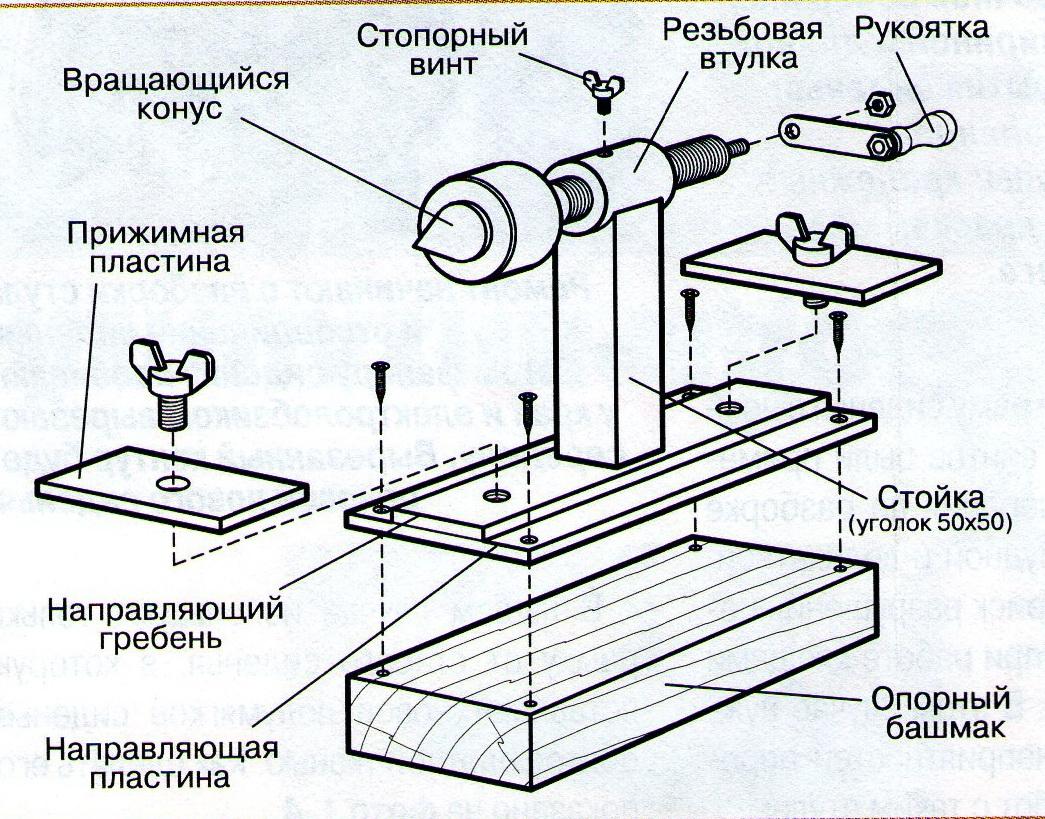
It is important to note that specialized devices are divided into three subtypes:
- Turning and milling. With their help, you can make, process and bore grooves.
- Turning screw. Such a woodworking type of specialized machine is used to work with cone-shaped products, threading.
- CNC. Multifunctional devices that perform a whole cycle of woodworking operations. An important feature of the CNC module is that it automatically performs all the work. Operator involvement is minimal. Its task is to set desired program from the CNC list.
At the same time, any woodworking unit is capable of:
- crop;
- Turn;
- Drill;
- Make grooves;
- Cut thread;
- Make holes;
- Turn the ends;
- Sanding;
- Make openings.
Specifications
Many craftsmen make a wood lathe with their own hands, while others prefer to purchase ready-made devices. When there are such models on the market as STD 120m, Corvette 74, STD 1000, Holzstar db1100, no chisels or planers are needed.
Experts advise focusing on the following parameters.
- Motor power. Electric motors determine the processing capabilities of the machine, but at the same time affect energy consumption. Industrial models use engines with a power of 1-2 kW. And for domestic needs choose 300-500 watts.
- Workpiece sizes. Here you should pay attention to the center-to-center distances and to the machine bed.
- Spindle head rotation speed. This is the main working tool capable of rotating at a frequency of 400 to 35,000 revolutions per minute. The quality of processing products directly depends on this parameter.
- manufacturer and warranty. Many experts recommend choosing brands like Corvette, STD and Holzstar.
The choice on the presented versions of devices is not limited, but they are well-deservedly popular.
Design features
Let's study general principle design of such equipment.
- The basis is the bed, the quality of which determines the accuracy of woodworking and the stability of the turning equipment itself. All elements and mechanisms are located directly on the frame. The best option for manufacturing the bed is cast iron and solid casting.
- Workpieces are mounted in driving chucks, which are located on a rotating spindle. A faceplate or tailstock with a rear chuck allows you to fix the product from two sides at once.
- Depending on the length of the cutter, the thrust bearing moves. The cutter partially rests on it during the processing of workpieces.
- Workpieces can be fixed in two ways. For the first, the centers of two cartridges are used, and for the second, a faceplate. If you prefer to make yourself a homemade wood lathe, you will need a faceplate when turning the ends. The peculiarity is that the faceplate provides for fastening products with bolts, and not with points. The faceplate is preferable because it fixes the product more securely.
- The most important design difference between turning units for metal and woodworking is that the woodworking option provides manual feed cutter to the product.
Popular Models
Working on a wood lathe is a fairly common event in home workshops and industries. If you need a unit for personal purposes, drawings, photo and video instructions will allow you to make an excellent unit with your own hands.
Or pick up the chisels and get to work. Chisels are an outdated alternative to woodworking machines. So chisels, planers and others hand tools will not allow you to achieve the same result as automated chisels, that is, machines. With CNC they will be or without a CNC module, you decide.
The list of popular models includes such modern "chisels":
- Corvette 74;
- STD 1000;
- STD 120m;
- Holzstar db1100.
Let's consider them separately.
- The Corvette 74 is a 550W floor standing unit. The processing diameter and width are 300 and 845 mm, respectively. Corvette 74 weighs 85 kg. The range of spindle speeds on the Corvette 74 machine is from 500 to 2000 rpm. The current cost is 30 thousand rubles.
- STD 1000. Drive unit 22.9 kg. Limit diameter processing of the model is 350 mm. The power of the unit is 400 W, and the rotational speed is from 810 to 2480 rpm. The price of STD 1000 is about 11 thousand rubles.
- STD 120m weighs 100 kg and runs on 380 V. Power is 0.4 kW. The machining diameter is up to 190 mm, and the spindle speed STD 120m is from 1100 to 2150 rpm. The price is about 45 thousand rubles.
- The Holzstar db1100 is a 92kg German machine with 10 speeds and a maximum working diameter of 358mm. The unit is powered by 220 V. Estimated price- 55-60 thousand rubles.
Do you need a CNC model, a heavy-duty faceplate, and a wide range of adjustments if you're going to be doing regular small crafts? No. CNC and faceplate are the prerogative of modern, powerful devices with high functionality. If you want to make ordinary crafts, you can try to assemble the machine yourself.
If large-scale production is planned, work with large products, the faceplate as a latch will become indispensable, and the CNC module will simplify the work.

For everyone who is interested in turning, sooner or later the question of acquisition arises. A modern woodturning machine is a universal unit for mechanical processing of wood. It's built for multifunctional action. He has dozens of operations on his account. These are turning, threading, drilling, creating holes and puzzles. It processes ends, shaped blanks, conical and cylindrical surfaces. The lathe is equally indispensable for woodworking industries of various sizes, as well as for framing and carpentry workshops.
Buying a lathe requires a reasonable approach, a balance of all the pros and cons. After all, we are talking about very expensive equipment. How to choose a wood lathe so that the investment is justified? You can look at hundreds of sites, but you will never be sure of the correct choice. The first step is to designate the task area for the future machine. This will determine the selection options.
DESIGN AND DIFFERENT TYPES OF LATHES
The machine for turning wood works consists of:
- Beds (the basis for placing the necessary mechanisms and elements).
- Driver chuck (headstock). Responsible for the rotation of the workpiece.
- Spindle. Adjusts the rotation speed.
- Back grandma. Provides fixation of the part.
- Movable pedestal. Sets the optimal distance to the workpiece
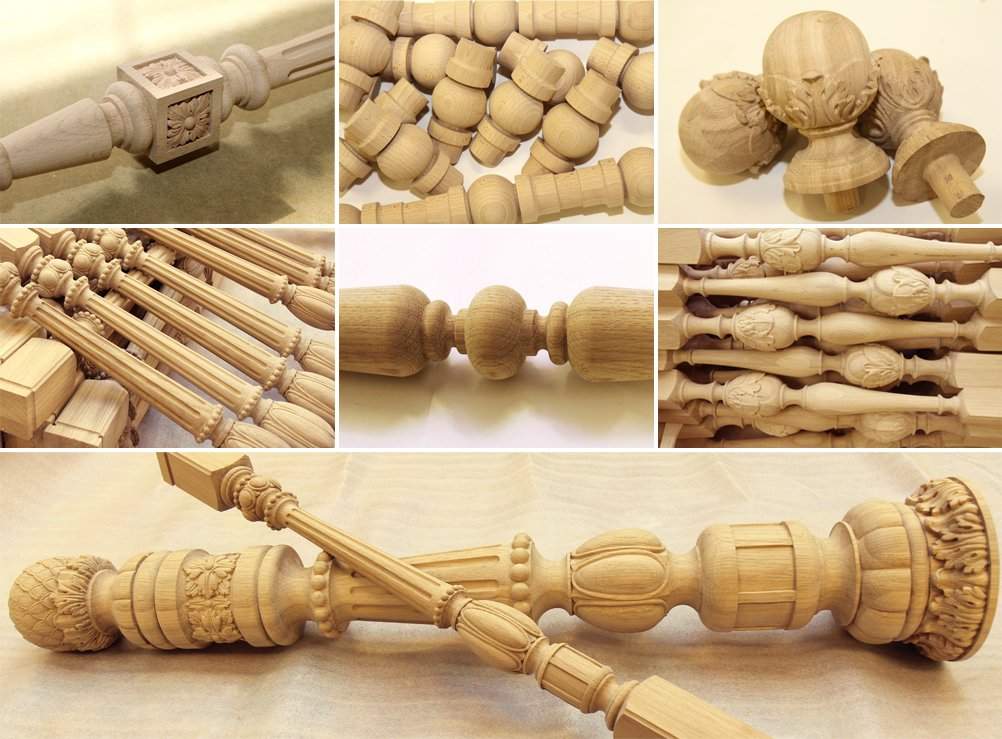
Examples of work done on a wood lathe
Lathes are desktop type and mounted on a bed. The beds can be cast iron, stable and durable. There are lightweight cast aluminum frames. Their advantage is the complete absence of corrosion. A desktop (portable) lathe is cheaper. It can also be installed on a special workbench or stand. To do this, there must be appropriate mounting holes on the housing.A wood lathe can weigh from 18 kg to 90 kg. The larger the weight value, the less vibration will be felt. It's comfortable. But for home craftsmen, buying overall lathes is unprofitable. You can get by with a mini-machine.
The machines also differ in phase. There are two options here - 220 V or 380 V. A single-phase machine is often bought for the home. It all depends on the network you have. A three-phase lathe is usually more powerful. This is a productive stationary equipment, so it is not needed for rare private housework.
The main criteria for choosing a lathe are the power and accuracy of processing parts. If turning is a hobby, then fundamental accuracy is not required. Of course, if it is possible to perform fairly accurate work on the machine, then this is good. But the price of a functional and very precision machine higher.Often masters working at home take care of silent operation. A low power machine makes less noise. If you choose a lathe from famous and reliable brands, then a very powerful engine also has noise protection.For a more detailed acquaintance, we have prepared the most important specifications lathes. They directly indicate their working potential.
POWER - THE MAIN INDICATOR OF PERFORMANCE AND ENDURANCE
When choosing power, the main thing is to decide what you need the machine for. If for a hobby or products from the category of "folk art", then buy an inexpensive household-class lathe. These are mini machines. They are ideal for small batch production. They start counting their power indicators from 350 watts and end at 500 watts. For medium-volume work, you should choose a wood lathe with a power of 500W-1000W.
The power of the lathe is over 1000 W - this is already relevant for the large-scale industrial sector. Important recommendation: for professional work with loads, choose more powerful machines. Then, when the index of turning or drilling is set to the maximum, you will not hear engine slip and a drop in speed from them. But if the motor is weak and does not pull the load, then this has a bad effect not only on the quality of work, but also on the engine resource.
DIMENSIONS OF PROCESSED WORKPIECES
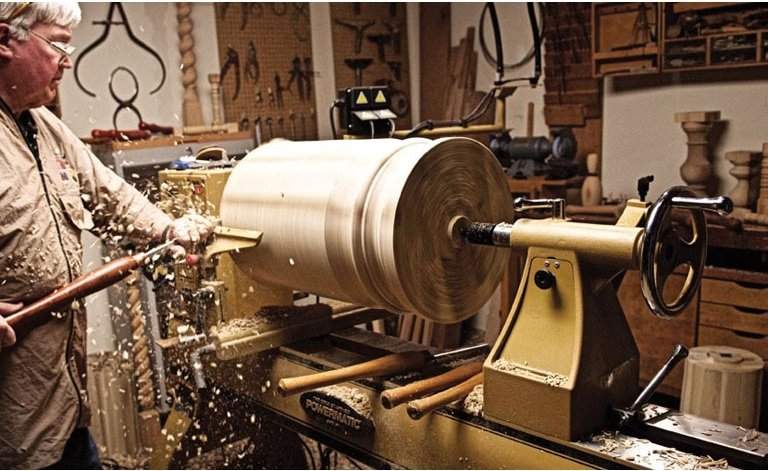
The length and diameter of the workpiece are important when choosing. For entry level works, you can buy a household lathe. It works with small blanks or medium-sized blanks. The length of such blanks is up to half a meter, the diameter is a quarter meter maximum. It is clear that you can’t accelerate much on a household machine.
If you need to process "hundreds" daily, then, of course, choose a wood lathe of a higher class. From professional equipment. Such machines have extension cords so that you can sharpen long details. It is possible to turn parts with a length of about 1 meter.
SPINDLE AND ITS FEATURES
Spindle speed and thread pitch determine productivity. That is, the speed and quality of processing. These two values are responsible for a timely and full-scale processing process. The higher the requirements for the volume and speed of work, the higher the spindle speed should be. It is clear that the power of the motor must match. The lower the power, the lower the spindle speed.
The very quality of processing depends on the indicators of the speed of rotation of the spindle. The spindle of the lathe can make from 400 to 3500 revolutions per minute. Quality machines always have a speed controller.
DISTANCE BETWEEN CENTERS

The part is fixed in two ways - between the centers of the rear and front headstocks or a faceplate. Accordingly, the values of these distances vary in three intervals in different machines. This can be a value up to 600 mm, up to 1000 mm and over 1000 mm. Here you need to choose the option you need, based on the dimensions of the material being processed. The distance between the centers determines the accuracy of the fastener. By fixing the part correctly, you will avoid part runout during rotation.
RPM ADJUSTMENT

When working on a lathe, there is a need to change the speed of rotation of the workpiece. For various operations it is necessary different speed. Speeds are chosen depending on the type of wood being processed and the required processing accuracy. Therefore, lathes are equipped with speed control.
There are two types of adjustment - smooth and stepped. Step adjustment is fixed at each value. The machine can have three to five speeds to choose from. To change them, groups of pulleys are installed. They throw the transmission belt to the desired point.
Smooth adjustment is considered an order of magnitude better. You do not need to stop the machine to change the speed. The process of switching speeds occurs smoothly, without jerks and fixations. The built-in variator is responsible for smooth adjustment.RPM control is directly related to RPM.
AVAILABLE DIGITAL DISPLAY
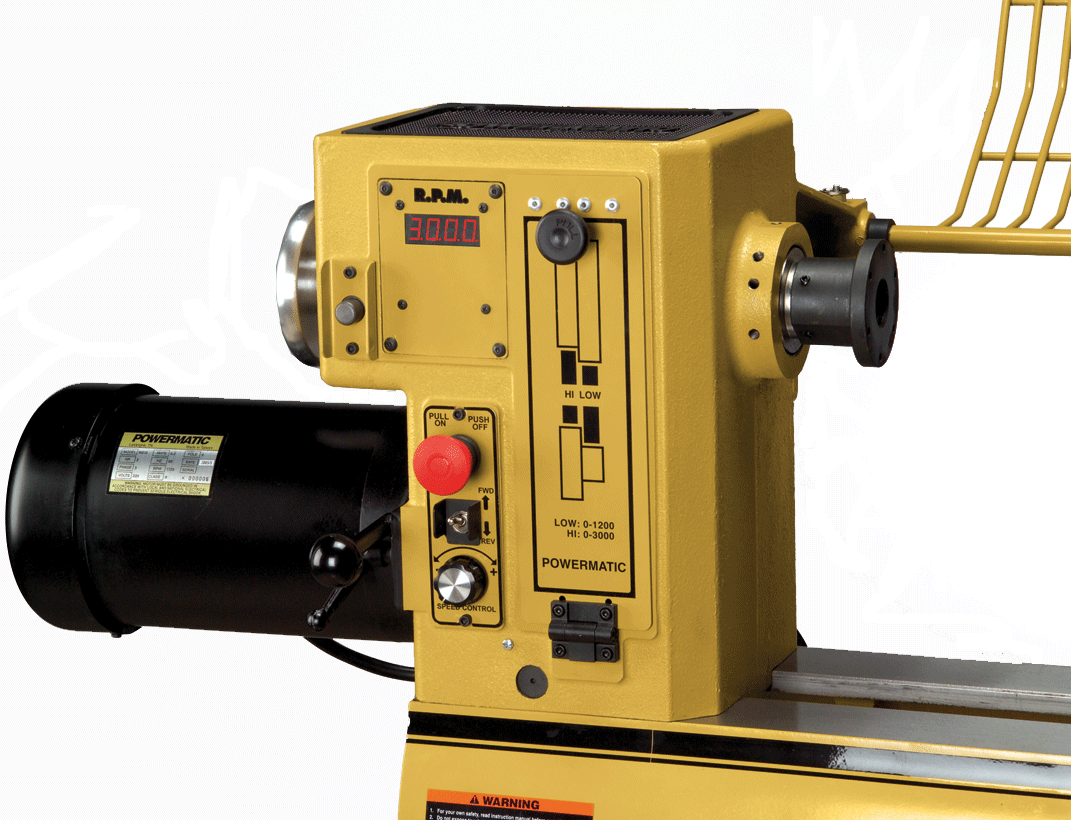
The digital display is a significant advantage in work. It displays a digital indication of rotational frequency on the headstock. This allows you to read speed values. With the help of the display, the adjustment is much more effective. You establish visual control over the work. This opportunity has a positive effect on the patency of problem areas.
INSTALLABLE COPIER
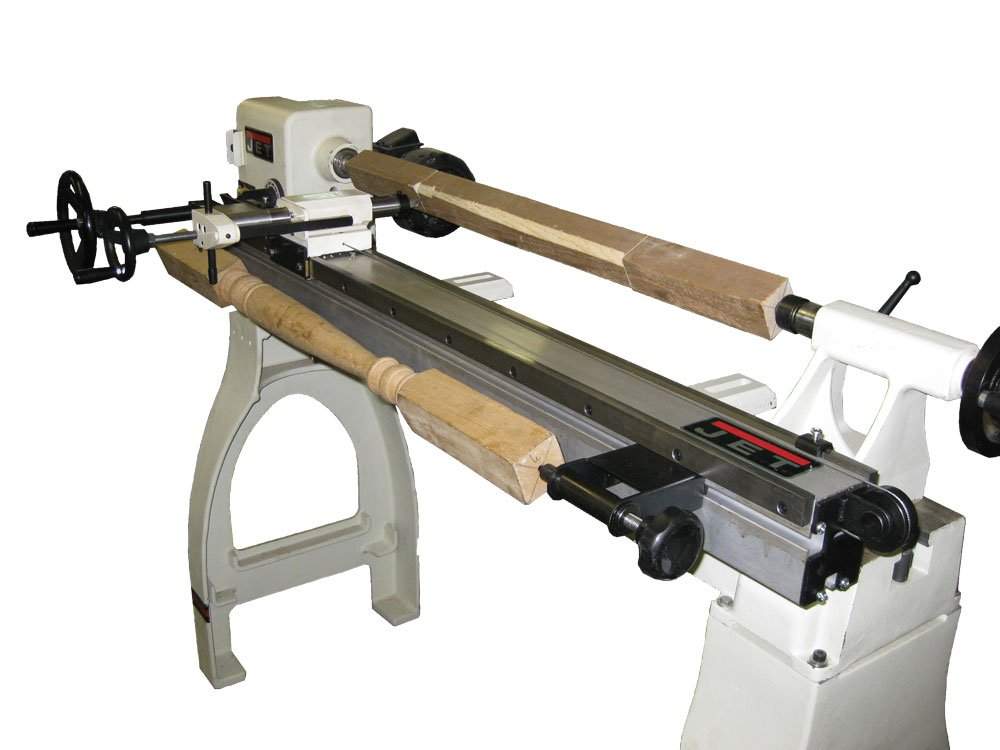
There are lathes with a copier installed, and there are no copiers installed. The copier is an additional option in the machine. It is an auxiliary device of a removable nature that turns a conventional wood latheto copier. Simplifies processing a large number products of the same type. The copier guides the cutter along a strictly defined trajectory, which prevents the appearance of a difference in the size and shape of the products. To increase the accuracy of work, it is worth choosing a lathe with a copier.
REVERSE SWITCH
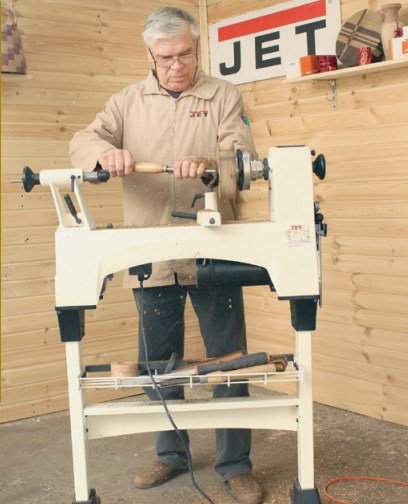
Reverse - reverse gear. This is also an additional feature. Not all machines are equipped with reverse. The essence of the reverse in the machine is that it provides the rear feed of the carriage and spindle. This speeds up the work. You do not need to re-feed the workpiece if the need arises for re-turning. You can just turn on the reverse function.
Which wood lathe is better - there is no definite answer. It all depends on your tasks, opportunities, professional knowledge and financial resources. Advice and feedback are also important.users.
Experience and the above points will guide you in choosing a wood lathe that meets your expectations.
With the help of such a machine, you can carve balusters for the porch and stairs to the attic, make turned parts for trim, intricate elements of the external and interior decoration houses, furniture details and much more.
The basis of a wood lathe is a single-phase electric motor with a power of about 1 kW or a three-phase electric motor with a power of about 1.5 kW, connected according to a capacitor circuit. It is better to choose an electric motor with a reduced number of revolutions per minute, no more than 1500 (preferably about 600-800).
About capacitor switching circuits three-phase motors in a single-phase network, it is necessary to tell in more detail.
Available big choice three-phase electric motors, but not all of them are suitable for inclusion in a single-phase network according to a capacitor circuit. So, for example, engines of the AO, A02, D, AOL, APN, UAD and some others series are good for these purposes. There are electric motors with a rated voltage of 127/220 V (the rated voltage of the electric motor is indicated on the passport-label on its body). Such electric motors are connected to a 220 V network through capacitors only according to the "star" (λ) scheme. Electric motors with a rated voltage of 220/380 V - according to the "triangle" scheme (Δ).
To obtain the maximum possible power on the shaft, the electric motors are connected to a single-phase 220 V network according to the scheme shown in fig. 117 a. Switch SA2 allows you to reverse the motor rotor.
The capacity of the working capacitor for an electric motor with a rated voltage of 127/220 V is determined by the formula:
Starting capacitors (C) in both circuits are chosen with a capacity of 1.5-2.0 times more than the working ones. Capacitors for the listed circuits must be paper-insulated (MBGO, MBGP, etc.) and designed for an operating voltage of at least 350 V: to the terminal block ends (where it is possible to switch the windings), then a scheme is used (Fig. 117, b), which gives the highest achievable power on the shaft.
The start of the motor is carried out as follows. Press the "Start" button and turn on the "Network" switch. As soon as the electric motor picks up speed, release the "Start" button. If, with the selected working capacitor, the engine becomes very hot during operation, select best option, reducing or increasing the capacitance of the working capacitor.
A faceplate is installed on the axis of the machine engine (Fig. 118, a). It has a central cone and four adjustable ones. The workpiece is mounted on them and securely fixed. For small parts use a smaller faceplate.
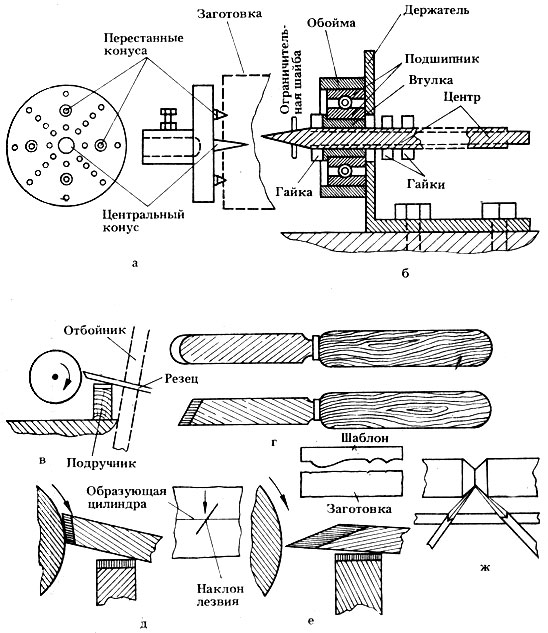
The second end of the workpiece is fixed in the center (Fig. 118, b). It is a corner holder welded from steel 4-5 mm thick. A holder is welded to the holder, into which a ball bearing is inserted with an interference fit. A steel turned bushing with a thread for the center is pressed into the central hole of the ball bearing. The center is a steel pointed rod with a thickness of at least 16 mm with a continuous thread along the entire length and two flats at the end (for turning the center). With the help of three nuts, the center is attached to the sleeve. The limit washer fits snugly on the pointed end. When installing the machine on a workbench, it is necessary to ensure that the central cone of the faceplate and the center cone are on the same line, that is, they are coaxial. With any movement of the center, this alignment must be strictly observed.
On the workbench during the operation of the machine, handcuffs are installed (Fig. 118, c). They are usually made in three sizes: long, medium and small. The latter is made so that it can be attached to the workbench under different angles. The cutter rests on the handpiece during operation.
Cutters can be made from flat files (Fig. 118, d). The rough (peeled) cutter has a semicircular shape. Its sharpening angle for hard wood is about 25 °, for soft wood - about 35 °. Finishing cutters are oblique in plan (with an angle of 70-80°), their sharpening angle is 20-30°. Sometimes finishing cutters are made with one-sided sharpening. The total length of the cutter (with handle) is about 500 mm.
The machine must be equipped with two wooden beams section 80X80 mm, the so-called chippers (Fig. 118, c). They are designed to throw the workpiece to the side if it breaks off the machine.
Before starting work on the machine, a workpiece is selected (preferably without knots, dry). For external parts, aspen is usually used; it withstands external influences well. For internal details, it is better to take linden - it is easily processed. Beech or oak are suitable for critical power parts. conifers poorly processed on a lathe.
Consider, for example, the manufacture of balusters. First, a quadrangular beam is planed. At the ends, a circle is drawn and a rough cylindrical billet is planed with an ax.
The workpiece is attached to the faceplate of the machine so that the cone stands exactly in the center of the marked circle. Lightly hit with a hammer on the other end of the workpiece so that the recesses from all five cones of the faceplate are indicated. According to this marking, five holes are drilled with a drill with a diameter half that of the diameter of each cone at the base. Hole depth - three drill diameters. At the other end, a hole for the center is also drilled according to the marking.
Insert the workpiece into the machine. To do this, with a hammer blow, they put it on the cone of the faceplate until it stops and bring the center under the hole. A lock washer is placed and the center is wrapped so that the lock washer is slightly pressed into the end of the workpiece. Screw the left nut all the way into the sleeve (Fig. 118, b). On the other side of the holder, the first nut is also screwed all the way into the sleeve and the second nut is used to lock it.
Install a long handrail and chippers. Turn on the engine. With a peeling cutter, they begin to remove chips no thicker than 1-2 mm (depending on the hardness of the tree). The incisor is held firmly with both hands and they make sure that it rests on the handpiece all the time (Fig. 118, c). In order for the cutter blade to grind evenly, it is brought to the workpiece at different angles.
The workpiece is processed rough until its diameter is 1.5-2.0 mm larger than planned. Then the work is carried out with a finishing cutter. The cutter is brought to the workpiece as shown in Fig. 118, e, and its blade is inclined with respect to the generatrix of the cylinder.
Having received the desired diameter, proceed to mark the balusters along the length using the prepared template. It is led by the sharp end of the finishing cutter (Fig. 118, e). In the same way, all narrow transitions are machined (Fig. 118, g). The rest of the processing (roundings, conical parts, etc.) is performed with a finishing cutter, as usual (Fig. 118, e). The control is carried out by templates, applying them to the part and ensuring that the outline of the part exactly matches the contours of the template.
The finished part, without removing it from the machine, is polished with abrasive skins (the skin is folded into a narrow strip and, holding by the edges, is brought to the part). Finally, the part is polished with wood shavings: holding a handful of shavings in your hand, press it against the surface of the rotating part.





